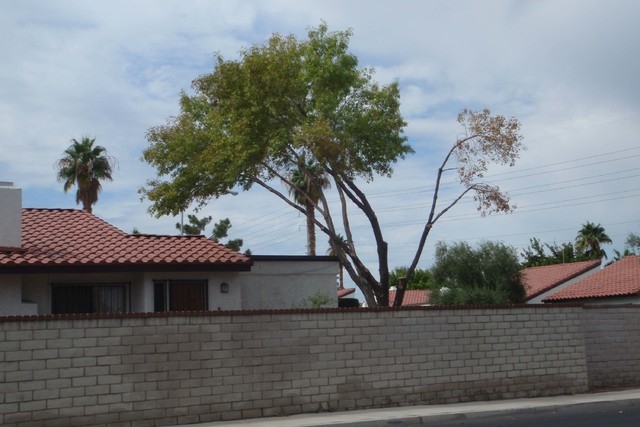Ash trees do not fare well in desert Southwest




Q: I have two 20-year-old ash trees that appear to be dying. I have attached pictures. The smaller tree is a Modesto ash and it started losing limbs about a year ago. The bark is now separating and it looks like an old stump with a few sprouts. The other is a Rayburn ash. Its limbs started dying this summer, but the limb deaths are accelerating.
I also am noticing ash trees all over our neighborhood in the same condition. What is happening and what can I do to save these beauties?
A: I’m sorry to hear about your ash trees. This is a fairly common problem with ash trees in our desert Southwest. I have been dealing with this problem, mostly on Modesto ash, for about 30 years. I no longer encourage people to plant ash trees in our climate because of this problem.
Plant samples have been sent to several plant pathology laboratories over many years, and no one has been able to find a plant disease pathogen.
We have been calling it ash tree decline, but we do not know why it is happening. Fertilizer applications and increasing the water does not seem to help. Ash trees planted in lawns are also affected.
The trees seem to die back from a lack of water to some of the limbs, but no one is certain why. All I can tell you is to remove them when they become a problem to public safety or just look bad.
Q: I have a very young Pink Lady apple tree with about six apples on it. The apples are green. How do I know when to pick them?
A: The fruit will ripen on its own. Wait until at least mid-November before picking them for best quality and highest sugar content.
Hopefully you thinned them to get some good size and kept watering them when needed, so lack of water does not affect their size or development.
They can hang on the tree until about mid-December, but you should be thinking of harvesting them by Dec. 1. Harvest earlier than this if you start to see bird damage.
Q: I have an ornamental eucalyptus tree in my backyard that is 20 feet tall and facing west. It has been steadily losing leaves and branches the past two years. Also, a black sap has been oozing through the bark; it crystalizes into a hard substance. Can you provide a diagnosis and treatment?
A: Your description of this problem about your eucalyptus bothers me. The loss of leaves, the branches dying back, coupled with black sap oozing through the bark, is a good sign of eucalyptus borer.
To my knowledge, this insect is not been reported in Southern Nevada. It has caused a lot of destruction in eucalyptus in California.
I would consult this information from California: www.ipm.ucdavis.edu/PMG/PESTNOTES/pn7425.html
I am paraphrasing the California information: Holes in the bark and stains or oozing liquid on limbs or trunks are common symptoms of longhorned borer damage. When this borer is a problem, leaves can discolor and wilt, and limbs can die back.
Longhorned borers usually attack stressed or damaged plants, leaving vigorous, appropriately watered trees alone. Tree species with some resistance to these wood borers can produce copious amounts of resin in response to an attack.
Extensive larval feeding beneath the bark can spread around the entire circumference of a tree, girdling, or completely removing a strip of bark from, the trunk. Trees at this stage of infestation have a thin canopy with wilted or dry leaves, and the bark is cracked and packed with larval excrement. Infested trees usually die within of a few weeks of girdling, although resprouting can occur from the tree base.
If you believe this could possibly be the problem, I hope you would contact the Nevada Department of Agriculture and start asking questions and possibly preparing to send up samples Carson City for identification by the entomologist.
This borer usually attacks trees that are not getting enough water or are not being watered often enough or both. Nevada Department of Agriculture: 702-486-4690
Q: I’m new to Nevada and renting a house. I’m looking for plants that can stay in containers for at least a year, as we plan to take them when and if we move. I tried to grow some herbs, an eggplant, cactuses and flowering plants, but they all died.
A: If you are renting, I would encourage you to focus on annuals that you can use. I would not encourage you to buy fruit trees or landscape trees now and keep them in containers for planting later when you move.
You are better off buying those plants when you are ready to put them in the ground. There is just too high a risk that you’ll lose them before you plant them.
The small containers just do not hold enough water for these plants to make it through the summer months. Be prepared to water them daily. Use a good container soil when planting and avoid the cheapest soil you can buy.
Most plants usually do better with an eastern exposure rather than a southern or western exposure. In the wintertime, annual plants will frequently do better in the south and west exposures.
Read up on growing container plants on my blog: http://xtremehorticulture.blogspot.com/
Q: You had a post on your blog about red bird of paradise bush. Will this bush hurt my dog? I don’t think she would grab the flowers. I want to grow a big bush in this area of my backyard as my deceased husband loved the flowers. I heard the bush is poisonous.
A: Like so many plants, the dose makes the poison. Yes, this plant, if it is taken in large quantities, would be poisonous to dogs, cats, humans, etc.
However, I would point out to you that this plant is also sold, the leaves and stems primarily, for Ayurvedic medicine and has been found by researchers to have antiulcer and anti-inflammatory properties.
Please keep in mind that about 80 percent of all landscape plants are poisonous. Some are more poisonous than others. Take as examples oleander and the castor bean plant.
Many of our houseplants are also poisonous, such as mother-in-law’s tongue or snake plant and many others.
In small quantities, I would not be too concerned. However if an animal consumed a lot of the plant it might cause harm or worse.
I will not tell you that it is nontoxic and not to have some concern about it. But on the toxicity list I would probably put it as mildly toxic. So keep your pets away from it if they tend to chew on things. I would also not use the flowers as a garnish for a meal.
Bob Morris is a horticulture expert living in Las Vegas and professor emeritus for the University of Nevada. Visit his blog at xtremehorticulture.blogspot.com. Send questions to Extremehort@aol.com.


















